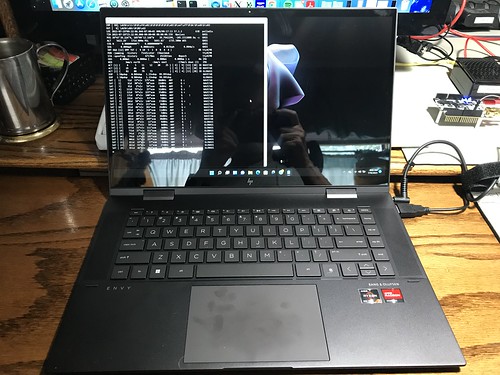I recently bought a new laptop that runs Microsoft Windows 11.
And I didn't immediately install a Linux distro over top of Windows.
Shocking, I know, for a guy who for years has been, and remains, firmly in the Apple ecosystem: laptop, desktop, phone, and tablet. And who, for the past few decades, has been writing software for the Linux ecosystem (including for Android). But I didn't own a hardware platform that can run Windows 11, which only works on systems that have a Trusted Platform Module (TPM). And a lot of the commercial tools for embedded systems, and vendor tools for GNSS devices, that I use only run on Windows.
I bought a 2022 HP Envy x360 Convertible Model 15. That's a laptop with a 15.6" touch sensitive screen that folds up to convert into a tablet. It's the first hardware platform I've run my code on that uses an AMD processor: a Ryzen 7 5825U. It came with Windows 11 Professional. It has 64GB of RAM, and a 2TB PCIe SSD.
So of course almost the first thing I did was get Microsoft's Windows Subsystem for Linux (WSL) working on it. This allows you to run a full blown Linux/GNU distro - not an emulation layer - with a Linux kernel, in a highly optimized virtual machine environment native to Microsoft. Then I got my own software running on it, my Diminuto and Hazer repositories.
It was mostly straightforward, although getting a USB device (in my case, a GNSS receiver dongle) attached to the Linux environment was a little weird - definitely weirder than doing the same thing using the commercial VMware software, which I have done many many times.
Here's a snapshot of my GNSS software, gpstool, running under Ubuntu Linux, under Windows 11, on the new laptop.
I have come to think of the WSL window as the "system console" for the running Linux. If you do an ifconfig command in this window, you can get the local IP address for the Linux instance. Using that address, you can ssh into Linux from Windows and have multiple concurrent Linux sessions. I use the popular Windows app PuTTY - which I also use to connect to serial-attached devices - but anything similar, like using the Windows' native ssh command from a PowerShell console, should work.
You can easily tell that the NMEA 0183 data stream from the GNSS device is running through some kind of USB bridge software layer under Windows that adds significant latency. My GNSS software displays, second by second, both the local system clock (LOC) and the GPS time from the incoming NMEA data (TIM). On this system, they consistently differ by one second, TIM running one second late. I have seen this also when running under VMware, but never when running natively on a system. Definitely won't be using this approach for precision timing, but it should be fine for geolocation.
I've found an issue with one of my USB-attached GNSS receivers, that the optional Windows usbipd utility, which you use to manage the connection of USB devices to WSL, refuses to attach to Linux: "device is in an error state". It's the one dongle I have that uses the Data Carrier Detect (DCD) indication to provide the GNSS one-pulse-per-second ("1PPS") signal. It works fine natively with Linux on, for example, a Raspberry Pi. Other USB-attached GNSS devices have worked fine.
Otherwise: so far, so good.


No comments:
Post a Comment